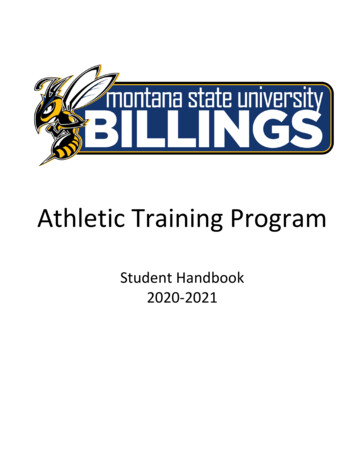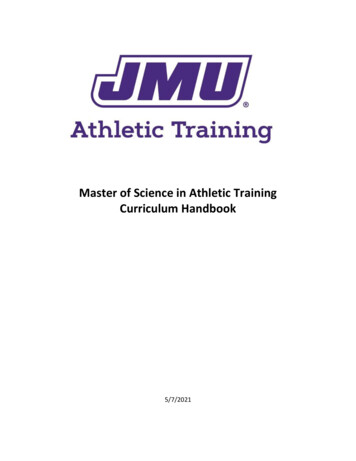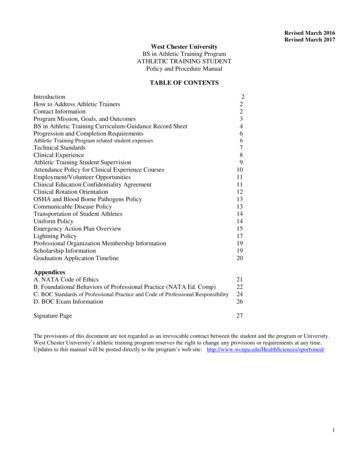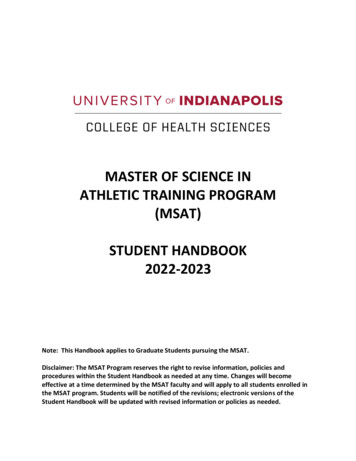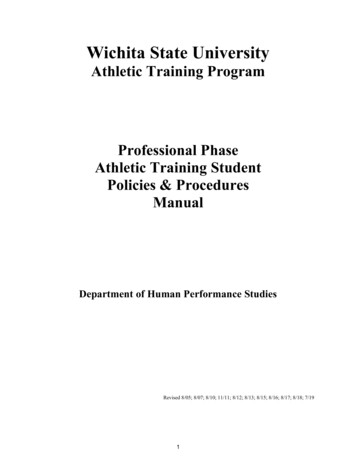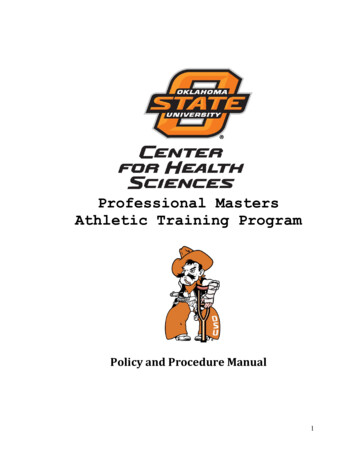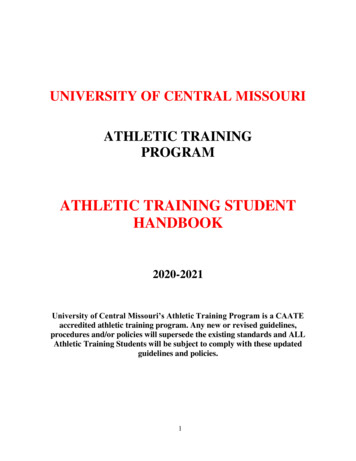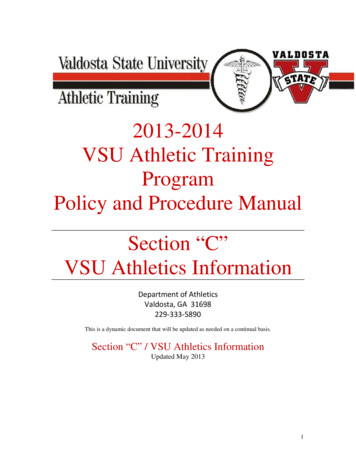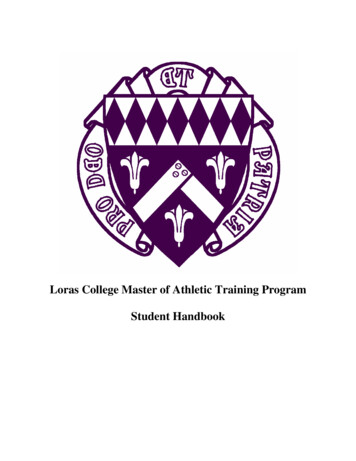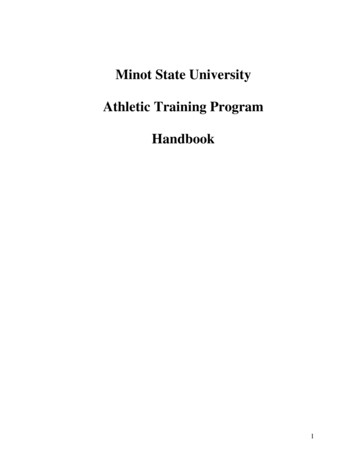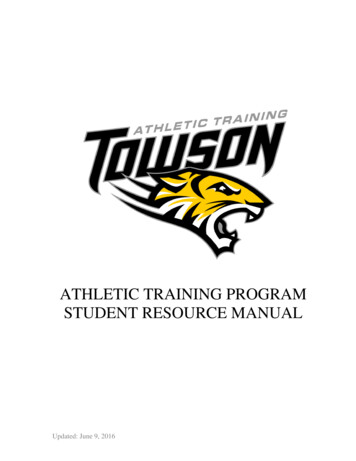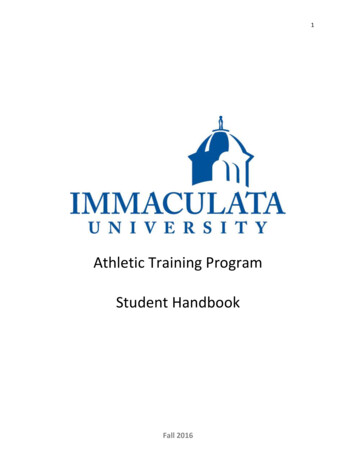
Transcription
1Athletic Training ProgramStudent HandbookFall 2016
2TABLE OF CONTENTSTable of ContentsI.Athletic Training Program Overview5A.Accreditation5B.Athletic Training Program Mission Statement:5C.Athletic Training Program Goals:5D.Athletic Training Program Learning Outcomes:5E.People you should know6II. National Athletic Trainers’ Association (NATA) Code of EthicsIII. BOC Standards of Professional Practice78I. Practice Standards9II. Code of Professional Responsibility10IV. The Athletic Training Student12A.Athletic Training Student Characteristics12B.Athletic Training Student Responsibilities12C.Athletic Training Room Duties14V.Athletic Training Program Academic Requirements15A.Admission Requirements Specific to AT Program15B.Retention Requirements Specific to AT Program16E.AT Program Curriculum Requirements17F.AT Program Course Sequence Sheet18VI. Clinical Education Requirements19A.Purpose19B.Placements19C.Clinical Sites and Contacts19D.Transportation policy19E.Travel policy19F.Remuneration for Services20G.Clinical Requirements during preseason and/or breaks20H.Season Off Policy20I.Gator/Golf Cart Usage Policy20Fall 2016
3J.Inclement Weather Policyc20K.Athletic Training Student-Athlete In Season Policy20VII. Athletic Training Program Specific Policies23A.Dress Code/Appropriate Attire23B.Additional Financial Costs23C.First Aid & CPR/AED Requirements24D.Liability Insurance24E.Drug and Alcohol Policy:24F.Student-Athlete Policy24G.Outside J.Professional Relationships Policy26K.BOC Exam Eligibility24VIII. Athletic Training Program Code of Conduct and Disciplinary Procedures29A.Athletic Training Student Conduct29B.Disciplinary Procedures29C.Appeal Policy29D.AT Program Grievance Policy29IX. Other Policies Related to AT PROGRAM30A.Health Insurance Portability and Accountability Act (HIPAA)30B.Bloodborne Pathogens Policy30C.Communicable Disease Policy31D.Colonial States Athletic Conference (CSAC) Lightning Policy32X. Athletic Training Student OrganizationXI. In Service Training/Educational OpportunitiesXII. Professional Organizations353536A.National Athletic Trainers’ Association36B.Eastern Athletic Trainers’ Association36C.Pennsylvania Athletic Trainer’s Association36D.American College of Sports Medicine37E.National Academy of Sports Medicine37F.National Strength and Conditioning Association37Fall 2016
4XIII. APPENDICES38Appendix A - Clinical Education Terminology39Appendix B: AT Program Application43Appendix C: Academic Progress Form47Appendix C: Clinical Course Competencies49Appendix D: Instructions for Using ATrack64Appendix E: Signature Forms66AT PROGRAM Student Handbook Acknowledgement66Technical Standards for Admission67Technical Standards Certification Form69Student Athlete Acknowledgement Form71Student Athlete In-Season Policy Form71Athletic Training Student Communicable Disease Policy74Athletic Training Student Code of Conduct75Athletic Training Student Confidentiality Statement76Immaculata University Travel Agreement77AT PROGRAM Student Payment for Services78Fall 2016
5I.Athletic Training Program OverviewA. AccreditationThe Bachelor of Science in Athletic Training Program at ImmaculataUniversity is accredited by the Commission on Accreditation of AthleticTraining Education (CAATE), 6835 Austin Center Blvd, Suite 250, Austin,TX 78731-3101. Initial accreditation was awarded in June 2014. The nextcomprehensive review is scheduled to occur during the 2019-2020accreditation year (Self-Study due July 1, 2019).B. Athletic Training Program Mission Statement:The mission of the Athletic Training major at Immaculata University is to provide acomprehensive learning experience within the discipline of athletic training that integratesscientific inquiry, theoretical knowledge, and clinical practice. Grounded in the mission ofImmaculata University, students will receive an education rooted in Christian core values,academic rigor and ethical integrity.C. Athletic Training Program Goals:The goals of the Athletic Training major are to:1. Provide students with the knowledge, skills, and clinical integration proficienciesessential for Board of Certification eligibility2. Prepare students for meaningful careers in athletic training and various healthcaresettings3. Prepare students for the diverse and changing world of healthcare4. Encourage a lifelong commitment to learning and professional excellence.Athletic Training Program Learning Outcomes:Upon completion of the athletic training curriculum students will be able to:1. Demonstrate evidence-based knowledge of athletic training practices and showproficiency in the eight areas of athletic training competency.2. Demonstrate knowledge and practical skills in injury prevention and risk management ofathletic injuries and illness.3. Recognize and identify signs and symptoms and perform appropriate evaluationtechniques in order to make appropriate diagnosis of athletic injuries and illness.4. Demonstrate critical decision making and problem solving skills that are essential in themanagement of athletic injuries and illnesses.5. Design, implement, and assess treatment and rehabilitation protocols and reconditioningprograms.6. Demonstrate critical decision making and problem solving skills that are essential toathletic training facilities and health care administration.7. Demonstrate understanding of the importance of ethical decision-making within thescope of professional practice.8. Exhibit personal leadership skills essential for success in the athletic training.9. Integrate technology into professional practice.Fall 2016
610. Demonstrate effective written and oral communication skills in academic andprofessional activities.11. Apply and synthesize athletic training knowledge to current issues in the variety ofathletic training settings.12. Demonstrate understanding of the importance of involvement within the NationalAthletic Trainers’ Association as a student and a professional through an appreciation oflifelong learning.D. People you should knowFull-Time FacultyKelly A. Stalker, Ed.D., ATCMichele Monaco, DSc., ATCBarbara Gallagher, M.Ed.Laurie DiRosa, Ed.D.AT – Program DirectorAT – Coordinator of Clinical EducationExercise ScienceExercise SciencePart-Time FacultyDawn Schramm, ATCDan Holman, ATCAdjunct InstructorAdjunct InstructorImmaculata University - On Campus PreceptorsAndrew WaerHead Athletic TrainerJenna CharlesAssistant Athletic TrainerSara MiragliaAssistant Athletic TrainerMedical Director & Associated PhysiciansDr. Kevin WalshAT Program Medical DirectorDr. John KellyAdvisory Board Medical AssociateDr. Chris MehalloImmaculata University Team PhysicianApproved Sites & Head PreceptorAcademy of Notre DameBishop ShanahanDowningtown East High SchoolEpiscopal AcademyGreat Valley High SchoolKinetic Physical TherapyPhoenixville High SchoolSpring-Ford High SchoolStrathaven High SchoolSwarthmore CollegeWidener UniversityYSC Sports AcademyKaren FoxTBD (Kinetic PT)Mike CaseyCathy HoltKeith JohnsonAngelo LabrinakosMark AgatoneDan HolmanJason LutyMarie ManciniAJ DuffyKaiti JonesFall 2016
7II.National Athletic Trainers’ Association (NATA) Code of Ethics(Updated June 2016)PreambleThe National Athletic Trainers’ Association Code of Ethics states the principles of ethical behavior thatshould be followed in the practice of athletic training. It is intended to establish and maintain highstandards and professionalism for the athletic training profession. The principles do not cover everysituation encountered by the practicing athletic trainer, but are representative of the spirit with whichathletic trainers should make decision. The principles are written generally; the circumstances of asituation will determine the interpretation and application of a given principle and of the Code as a whole.When a conflict exists between the Code and the law, the law prevails.1. Members Shall Practice with Compassion, Respecting the Rights, Welfare, and Dignity of Others1.1 Members shall render quality patient care regardless of the patient’s race, religion, age, sex, ethnicor national origin, disability, health status, socioeconomic status, sexual orientation, or genderidentity.1.2 Member’s duty to the patient is the first concern, and therefore members are obligated to place thewelfare and long-term well-being of their patient above other groups and their own self-interest, toprovide competent care in all decisions, and advocate for the best medical interest and safety oftheir patient at all times as delineated by professional statements and best practices.1.3. Members shall preserve the confidentiality of privileged information and shall not release orotherwise publish in any form, including social media, such information to a third party notinvolved in the patient’s care without a release unless required by law.2: Members Shall Comply with the Laws and Regulations Governing the Practice of AthleticTraining, National Athletic Trainers’ Association (NATA) Membership Standards, and theNATA Code of Ethics.2.1 Members shall comply with applicable local, state, and federal laws and any state athletic trainingpractice acts.2.2 Members shall understand and uphold all NATA Standards and the Code of Ethics.2.3 Members shall refrain from, and report illegal or unethical practices related to athletic training.2.4 Members shall cooperate in ethics investigations by the NATA, state professionallicensing/regulatory boards, or other professional agencies governing the athletic trainingprofession. Failure to fully cooperate in an ethics investigation is an ethical violation.2.5 Members must not file, or encourage others to file, a frivolous ethics complain with anyorganization or entity governing the athletic training profession such that the complaint isunfounded or willfully ignore facts that would disprove the allegation(s) in the complaint.2.6 Members shall refrain from substance and alcohol abuse. For any member involved in an ethicsproceeding with NATA and who, as part of that proceeding is seeking rehabilitation for substanceor alcohol dependency, documentation of the completion of rehabilitation must be provided to theNATA Committee of Professional Ethics as a requisite to complete a NATA membershipreinstatement or suspension process.3: Members Shall Maintain and Promote High Standards in Their Provision of Services.3.1 Members shall not misrepresent, either directly or indirectly, their skills, training, professionalcredentials, identity, or services.3.2 Members shall provide only those services for which they are qualified through education orexperience and which are allowed by the applicable state athletic training practice acts and otherapplicable regulations for athletic trainers.Fall 2016
83.33.43.53.6Members shall provide services, make referrals, and seek compensation only for those services thatare necessary and are in the best interest of the patient as delineated by professional statements andbest practices.Members shall recognize the need for continuing education and participate in educational activitiesthat enhance their skills and knowledge and shall complete such educational requirementsnecessary to continue to qualify as athletic trainers under the applicable state athletic trainingpractice acts.Members shall educate those whom they supervise in the practice of athletic training about theCode of Ethics and stress the importance of adherence.Members who are researchers or educators must maintain and promote ethical conduct in researchand educational activities.4: Members Shall NOT Engage in Conduct that Could Be Construed as a Conflict of Interest,Reflects Negatively on the Athletic Training Profession, or Jeopardizes a Patient’s Health andWell-Being.4.1 Members should conduct themselves personally and professionally in a manner that does notcompromise their professional responsibilities or the practice of athletic training.4.2 All NATA members, whether current or past, shall not use the NATA logo in the endorsement ofproducts or services, or exploit their affiliation with the NATA in a manner that reflects badly uponthe profession.4.3 Members shall not place financial gain above the patient welfare and shall not participate in anyarrangement that exploits the patient.4.4 Members shall not, through direct or indirect means, use information obtained in the course of thepractice of athletic training to try and influence the score or outcome of an athletic event, or attemptto induce financial gain through gambling.4.5 Members shall not provide or publish false or misleading information, photography, or any othercommunications in any media format, including on any social media platform, related to athletictraining that negatively reflects the profession, other members of the NATA, NATA officers, andthe NATA office.III.BOC Standards of Professional PracticeImplemented January 1, 2006IntroductionThe mission of the Board of Certification Inc. (BOC) is to provide exceptional credentialing programs forhealthcare professionals. The BOC has been responsible for the certification of Athletic Trainers since1969. Upon its inception, the BOC was a division of the professional membership organization theNational Athletic Trainers' Association. However, in 1989, the BOC became an independent non-profitcorporation.Accordingly, the BOC provides a certification program for the entry-level Athletic Trainer that confersthe ATC credential and establishes requirements for maintaining status as a Certified Athletic Trainer(to be referred to as “Athletic Trainer” from this point forward). A nine member Board of Directorsgoverns the BOC. There are six Athletic Trainer Directors, one Physician Director, one Public Directorand one Corporate/Educational Director.Fall 2016
9The BOC is the only accredited certification program for Athletic Trainers in the United States. Everyfive years, the BOC must undergo review and re-accreditation by the National Commission for CertifyingAgencies (NCCA). The NCCA is the accreditation body of the National Organization for CompetencyAssurance.The BOC Standards of Professional Practice consists of two sections:I. Practice StandardsII. Code of Professional ResponsibilityI. Practice StandardsPreambleThe Practice Standards (Standards) establish essential practice expectations for all Athletic Trainers.Compliance with the Standards is mandatory.The Standards are intended to: assist the public in understanding what to expect from an Athletic Trainer assist the Athletic Trainer in evaluating the quality of patient care assist the Athletic Trainer in understanding the duties and obligations imposed by virtue ofholding the ATC credentialThe Standards are NOT intended to: prescribe services provide step-by-step procedures ensure specific patient outcomesThe BOC does not express an opinion on the competence or warrant job performance of credentialholders; however, every Athletic Trainer and applicant must agree to comply with the Standards at alltimes.Standard 1: DirectionThe Athletic Trainer renders service or treatment under the direction of a physician.Standard 2: PreventionThe Athletic Trainer understands and uses preventive measures to ensure the highest quality of care forevery patient.Standard 3: Immediate CareThe Athletic Trainer provides standard immediate care procedures used in emergency situations,independent of setting.Standard 4: Clinical Evaluation and DiagnosisPrior to treatment, the Athletic Trainer assesses the patient’s level of function. The patient’s input isconsidered an integral part of the initial assessment. The Athletic Trainer follows standardized clinicalpractice in the area of diagnostic reasoning and medical decision making.Standard 5: Treatment, Rehabilitation and ReconditioningIn development of a treatment program, the Athletic Trainer determines appropriate treatment,rehabilitation and/or reconditioning strategies. Treatment program objectives include long and short termgoals and an appraisal of those which the patient can realistically be expected to achieve from theFall 2016
10program. Assessment measures to determine effectiveness of the program are incorporated into theprogram.Standard 6: Program DiscontinuationThe Athletic Trainer, with collaboration of the physician, recommends discontinuation of the athletictraining service when the patient has received optimal benefit of the program. The Athletic Trainer, at thetime of discontinuation, notes the final assessment of the patient’s status.Standard 7: Organization and AdministrationAll services are documented in writing by the Athletic Trainer and are part of the patient’s permanentrecords. The Athletic Trainer accepts responsibility for recording details of the patient’s health status.II. Code of Professional ResponsibilityPreambleThe Code of Professional Responsibility (Code) mandates that BOC credential holders and applicants actin a professionally responsible manner in all athletic training services and activities. The BOC requires allAthletic Trainers and applicants to comply with the Code. The BOC may discipline, revoke or take otheraction with regard to the application or certification of an individual that does not adhere to the Code. TheProfessional Practice and Discipline Guidelines and Procedures may be accessed via the BOC website,www.bocatc.orgCode 1: Patient ResponsibilityThe Athletic Trainer or applicant:1.1 Renders quality patient care regardless of the patient’s race, religion, age, sex, nationality,disability, social/economic status or any other characteristic protected by law1.2 Protects the patient from harm, acts always in the patient’s best interests and is an advocatefor the patient’s welfare1.3 Takes appropriate action to protect patients from Athletic Trainers, other healthcare providersor athletic training students who are incompetent, impaired or engaged in illegal or unethicalpractice1.4 Maintains the confidentiality of patient information in accordance with applicable law1.5 Communicates clearly and truthfully with patients and other persons involved in the patient’sprogram, including, but not limited to, appropriate discussion of assessment results, programplans and progress1.6 Respects and safeguards his or her relationship of trust and confidence with the patient anddoes not exploit his or her relationship with the patient for personal or financial gain1.7 Exercises reasonable care, skill and judgment in all professional workCode 2: CompetencyThe Athletic Trainer or applicant:2.1 Engages in lifelong, professional and continuing educational activities2.2 Participates in continuous quality improvement activities2.3 Complies with the most current BOC recertification policies and requirementsCode 3: Professional ResponsibilityThe Athletic Trainer or applicant:3.1 Practices in accordance with the most current BOC Practice StandardsFall 2016
113.2 Knows and complies with applicable local, state and/or federal rules, requirements,regulations and/or laws related to the practice of athletic training3.3 Collaborates and cooperates with other healthcare providers involved in a patient’s care3.4 Respects the expertise and responsibility of all healthcare providers involved in a patient’scare3.5 Reports any suspected or known violation of a rule, requirement, regulation or law byhim/herself and/or by another Athletic Trainer that is related to the practice of athletic training,public health, patient care or education3.6 Reports any criminal convictions (with the exception of misdemeanor traffic offenses ortraffic ordinance violations that do not involve the use of alcohol or drugs) and/or professionalsuspension, discipline or sanction received by him/herself or by another Athletic Trainer that isrelated to athletic training, public health, patient care or education3.7 Complies with all BOC exam eligibility requirements and ensures that any informationprovided to the BOC in connection with any certification application is accurate and truthful3.8 Does not, without proper authority, possess, use, copy, access, distribute or discusscertification exams, score reports, answer sheets, certificates, certificant or applicant files,documents or other materials3.9 Is candid, responsible and truthful in making any statement to the BOC, and in making anystatement in connection with athletic training to the public3.10 Complies with all confidentiality and disclosure requirements of the BOC3.11 Does not take any action that leads, or may lead, to the conviction, plea of guilty or plea ofnolo contendere (no contest) to any felony or to a misdemeanor related to public health,patient care, athletics or education;, this includes, but is not limited to: rape; sexual abuse of achild or patient; actual or threatened use of a weapon of violence; the prohibited sale ordistribution of controlled substance, or its possession with the intent to distribute; or the use ofthe position of an Athletic Trainer to improperly influence the outcome or score of an athleticcontest or event or in connection with any gambling activity3.12 Cooperates with BOC investigations into alleged illegal or unethical activities; this includesbut is not limited to, providing factual and non-misleading information and responding torequests for information in a timely fashion3.13 Does not endorse or advertise products or services with the use of, or by reference to, theBOC name without proper authorizationCode 4: ResearchThe Athletic Trainer or applicant who engages in research:4.1 Conducts research according to accepted ethical research and reporting standards establishedby public law, institutional procedures and/or the health professions4.2 Protects the rights and well being of research subjects4.3 Conducts research activities with the goal of improving practice, education and public policyrelative to the health needs of diverse populations, the health workforce, the organization andadministration of health systems and healthcare deliveryCode 5: Social ResponsibilityThe Athletic Trainer or applicant:5.1 Uses professional skills and knowledge to positively impact the communityCode 6: Business PracticesThe Athletic Trainer or applicant:6.1 Refrains from deceptive or fraudulent business practices6.2 Maintains adequate and customary professional liability insuranceFall 2016
12IV.The Athletic Training StudentA. Athletic Training Student CharacteristicsThis is a non-exhaustive list of the personal characteristics necessary for success as an athletic trainingstudent and entry-level athletic trainer.1. Trustworthy and Dependable2. Honest and Ethical3. Adaptable4. Effective communicator5. Leader6. Decisive7. Consistent8. High Energy9. Interest in sports10. Positive attitude(Henry, T.J., Schneider, R.C., & Stier, W.F. (2009). Desirable qualities, attributes, and characteristics ofsuccessful athletic trainers – A national study. The Sport Journal, 12(2).)B. Athletic Training Student Professional BehaviorsThe Athletic Training Program strives to develop professional behaviors in each athletic training student.As a part of our evaluation process, these behaviors will be evaluated by a preceptor at the end of eachclinical experience. The professional behaviors expected of athletic training students are as follows:1. Demonstrates a professional attitude2. Demonstrates punctuality and promptness3. Dresses professionally and maintains professional personal appearance4. Demonstrates reliability and dependability5. Demonstrates organizational skills and manages time efficiently6. Demonstrates the ability to adapt well to changes7. Demonstrates emotional maturity8. Maintains professional rapport/relationship with others9. Communicates regularly with preceptor10. Reflects upon constructive feedback and modifies behavior as needed11. Demonstrates self-initiative12. Seeks preceptor assistance in proficiency development in a timely fashion13. Expresses thoughts effectively and concisely in verbal and written form14. Uses appropriate medical terminology15. Demonstrates the ability to understand and follow direction16. Maintains patient confidentiality17. Demonstrates ability to work as a team in diverse settings18. Demonstrates the core values of the profession and institution including; honesty, integrity,compassion, service, teamwork and empathy19. Understand the ethical and legal parameters within the scope of practice for athletic trainers20. Demonstrates ability to formulate appropriate questions and seeks out potential answers21. Demonstrates confidence in abilities22. Demonstrates overall motivation to learnAdapted from Florida International University’s Athletic Training Program Policy andProcedure Manual (2015). Retrieved fromhttp://cnhs.fiu.edu/at/ assets/ASSET%20DOCs/ms-at-p-p-manual.pdfFall 2016
13C. Athletic Training Student Responsibilities1. Attend all practices and games unless excused by the clinical education coordinator and/or thepreceptor.2. Communicate regularly with your preceptor.3. Follow the athletic training student dress code during all practices and contests.4. Arrive promptly to your clinical site at the time assigned and stay at your clinical site untilexcused by your preceptor.5. Assist the preceptor with preparation for, observation during, and clean-up following practices,rehabilitations, and athletic competitions.6. Assist in administering treatment and rehabilitation as trained.7. Assist in the maintenance of student athlete files.8. Maintain daily records of treatments and rehabilitation.9. Assist in the prevention of athletic injuries and hazardous situations to the attention of the athlete,coach, and/or preceptor.10. Complete daily athletic training room duties and other duties as assigned by the preceptor.11. Practice clinical proficiencies during down time in the athletic training room.12. Maintain confidentiality of athletes and medical conditions.13. Uphold all NCAA and CSAC rules and regulations.14. Follow all rules set by your clinical education site.15. Adhere to policies and procedures outlined in the athletic training student handbook.16. Represent Immaculata University’s athletic training program in a positive manner.Fall 2016
14D. Athletic Training Room Duties1. Keep the athletic training room clean at all times.a. Wipe down tables and equipment between student athletes.b. Return equipment to appropriate location when finished.c. Sweep debris off the floor.d. Empty trash cans when full.e. Clean sink area following usage.2. Assist athletes immediately when they come into the athletic training room.a. Perform wound care as trained.b. Inform the preceptor of athlete needs.3. Maintain athletic injury reports, treatment logs and rehabilitation protocols.4. Keep taping area and kits stocked and cleaned.5. Notify the athletic trainer when the supplies are low.6. Report all mechanical problems with equipment.7. Make heel and lace pads.8. Maintain water level in the hydrocollators.9. While at practice:a. Keep water bottles off the groundb. Face the field or court at all times.c. If multiple athletic training students are at practice, avoid congregating as a group.d. Assist with wound care.e. Activate and/or perform your role in the emergency action plan when necessary.10. Clean coolers and whirlpools daily.11. Make sure everything is cleaned and put away before leaving.12. Perform all duties as listed at the clinical site or assigned by the preceptor.These are just a few of the daily duties that allow for the athletic training facility to runsmoothly. These duties are essential for the student athlete to complete in order to assist theathletic trainer with effective management of the facility and allow for more clinical educationexperiences. Please be familiar with the duties at each facility in which you are assigned.Each clinical education site will have their own policies & procedures for you to follow, inaddition to assigning daily tasks that need to be completed. It is the students’ responsibility toknow their required tasks and perform them without the prompting of the preceptor. Preceptorscommunicate with the Coordinator of Clinical Education on a regular basis and will report ifthese duties are not being completed successfully. This will result in a disciplinary warning for afirst offense and subsequent disciplinary actions for further offenses.Fall 2016
15V.AT PROGRAM Academic RequirementsA. Admission Requirements Specific to Athletic Training MajorAll students interested in majoring in Athletic Training will be accepted into the PreProfessional phase of the major. All students who wish to enter the Professional phase inAthletic Training must complete a formal application process. Applications will be reviewedat the completion of each semester. All applicants (freshmen, transfers, and upperclassmen)must meet the following requirements: Minimum of 30 college credits Minimum cumulative GPA of 2.7 or above Achieve a “C” or better in the following courses:oBIOL 209 Human Anatomy and Physiology IoBIOL 210 Human Anatomy and Physiology IIoATEP 201 Foundations in Athletic TrainingIn addition, applicants will submit the following information to the Program Director tocomplete the application process: Athletic Training Program Application Personal Essay answering the prompt provided by the Athletic Training Program Letters of Recommendation from two of the following individuals:oHigh school or college faculty memberoHigh school or college athletic director or coachoCertified Athletic TraineroSupervisor of a previous volunteer experience in the health care fieldStudents meeting the requirements for eligibility will complete an interview process.Admission to the professional phase of the Athletic Training major will be based onacademic qualifications and application materials. A limited number of students will beaccepted to the professional phase of the Athletic Training major. Students will receivenotification of the a
C. Athletic Training Program Goals: 5 D. Athletic Training Program Learning Outcomes: 5 E. People you should know 6 II. National Athletic Trainers' Association (NATA) Code of Ethics 7 III. BOC Standards of Professional Practice 8 I. Practice Standards 9 II. Code of Professional Responsibility 10 IV. The Athletic Training Student 12 A .
